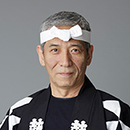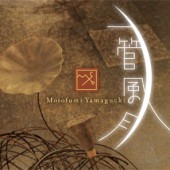Tag ‘Ikkan Fugetsu’
“Ikkan Fugetsu Vol. 2: Tomoshibi” by Motofumi Yamaguchi
Ikkan Fugetsu Vol. 2: Tomoshibi
On July 10, my second album “Ikkan Fugetsu Vol. 2: Tomoshibi” was released at long last! Thank you for your patience and support, everyone.
For this album, I didn’t limit myself to playing Japanese songs since I play a Japanese bamboo flute… I decided to include a wide range of songs that I like, ranging from Russian folksongs to American sprituals, from my own originals to Uyghur folksongs.
I invited Mikio Tsuji (eleven-string alto guitar), Yumi Nogami (piano & vocals), and Yoshie Abe (tategoto [vertical koto harp] & vocals) to collaborate with me on the album. They are all such unique performers and they shared their talents without restraint. I chose my bamboo flute, either makobue or shinobue, especially to suit each song… but actually, I really had no choice but to play a shinobue for many of the pieces to suit the delicate tones of Mr. Tsuji’s guitar and Ms. Abe’s harp.
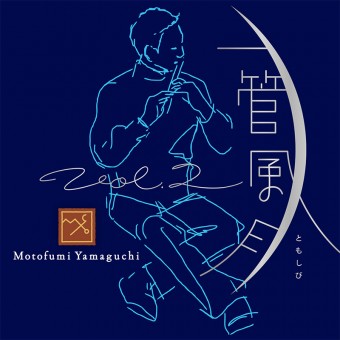
Just like on my first album, the last track is kind of like a bonus track, so to speak. I dedicated this track to the late Akira Nino, the pianist who performed on my debut album. I thought the lyrics of “Nobody Knows the Trouble I’ve Seen” sounded like his inner monologue during his life, so I chose this piece for him. When you listen to it, when the lyrics say the word “Lord,” please think of the word “Music.”
By the way, here’s the word on the street:
“Music these days is all downloadable, cheap and convenient.”
“Not at all, it is better to buy a CD that spins and have a cover to hold and read.”
And here’s what I say:
“One or the other, or both, I don’t mind… just please listen to the music.”
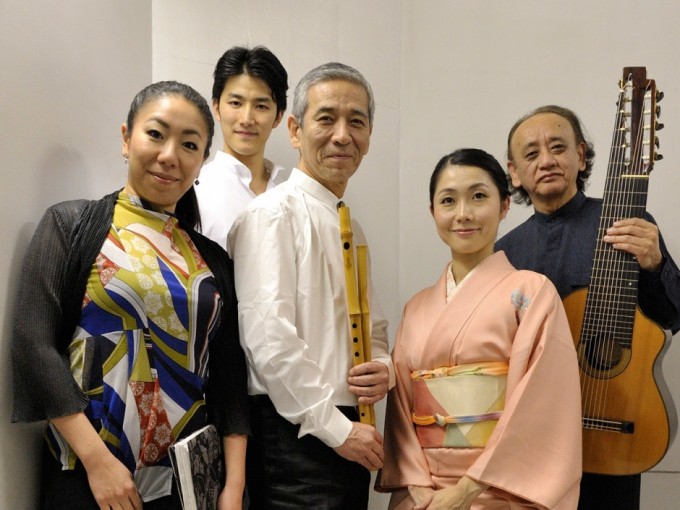
At the “Gin-iro no Kaze” Concert on Dec. 18, 2015. From left: Yumi Nogami, Kosuke Urushikubo (Kodo), Motofumi Yamaguchi, Yoshie Abe, and Mikio Tsuji.
Discography | Ikkan Fugetsu Vol. 2: Tomoshibi
http://www.kodo.or.jp/discography/od012_en.html
 [CD] Motofumi Yamaguchi “Ikkan Fugetsu Vol. 2: Tomoshibi” at Kodo Online Store
[CD] Motofumi Yamaguchi “Ikkan Fugetsu Vol. 2: Tomoshibi” at Kodo Online Store
http://kodo.shop.multilingualcart.com/goods_en_jpy_80.html
July 10 New Release: “Ikkan Fugetsu Vol. 2: Tomoshibi”
Announcing the July 10 Release of Motofumi Yamaguchi’s Second Solo Album “Ikkan Fugetsu Vol. 2: Tomoshibi”

All seven of these peaceful, contemplative recordings were created in the naturally serene surroundings of Kodo Village on Sado Island. Centered around the bright, crisp tones of the makobue & shinobue bamboo flutes, “Tomoshibi” floats across a rich sonic landscape: from the intricate harmonics of the eleven-string alto guitar, to a passionate duet where flute and piano intertwine in the Russian folksong, “Огонёк,” also known as “A Little Light” in English & “Tomoshibi” in Japanese. Ikkan Fugetsu Vol. 2 Tomoshibi also includes the soulful spiritual “Nobody Knows the Trouble I’ve Seen,” which is dedicated here to the late Akira Nino, the pianist who performed on the debut “Ikkan Fugetsu” album released in 2009.
Release Date: July 10, 2015
Discography | Ikkan Fugetsu Vol. 2: Tomoshibi
http://www.kodo.or.jp/discography/od012_en.html 
Available from July 10 from Kodo Online Store! http://kodo.shop.multilingualcart.com/goods_en_jpy_80.html
Motofumi Yamaguchi: An Interview by Johnny Wales
Motofumi Yamaguchi: An Interview by Johnny Wales
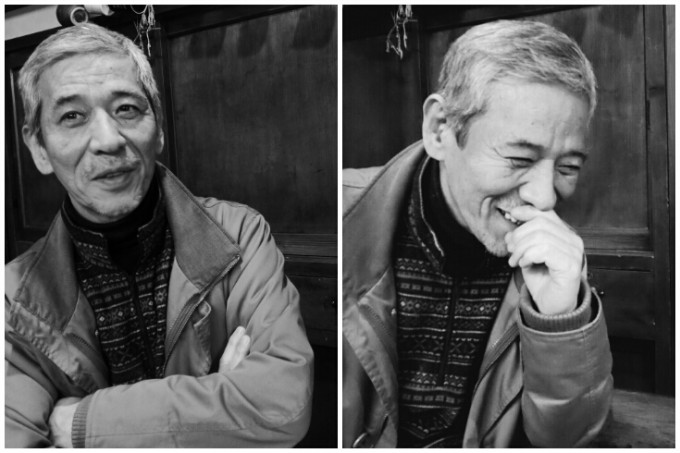
Motofumi, mid-interview (Photos: Johnny Wales)
Composer, arranger, fue (bamboo flute), koto (Japanese harp), shamisen (Japanese banjo-like stringed instrument), kokyu (Japanese violin), flute, cello and piano player Motofumi Yamaguchi was born in 1954 in Ibaraki Prefecture, just up the coast from Tokyo. His family moved to the big city when he was five years old. At high school and university (The Musashino Academy of Music) he studied Western classical music, composition, piano, cello and flute.
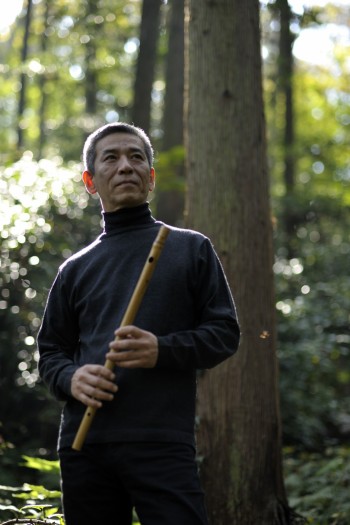
Photo: Takuro Susaki
In those days classical Japanese music was not generally held in very high regard among fellow students, and even some of the staff. It was seen as not quite as real as music from say, Germany or Italy. Motofumi began to feel this was very strange. Why shouldn’t Japanese have greater respect for their native culture? So he began seeking out performances of Noh and Kabuki, shamisen, koto and even Buddhist shomyo chanting. He was pleasantly surprised to discover that they felt very comfortable to him. He began to sense that he would be able to express himself more naturally in Japanese genres than Western. And so, at the age of 18, he began to study under shamisen (jiuta style) and koto teachers living nearby. He was surprised at how quickly he progressed and began to think that he had discovered a better, more natural direction for his career.
He was also beginning to tire of the big city and to dream of a life making music in the country. One day, while listening to his car radio, he heard vocalist and composer Ryudo Uzaki talking enthusiastically about his wonderful experience making music on Sado Island with a taiko group called Sado no Kuni Ondekoza. He talked about how amazing not only the taiko, but the koto and shamisen sounded too. Motofumi was fascinated and so went out and bought the two available Ondekoza records. They changed his life. As koto and shamisen were two of his instruments, he thought the group might have some use for him. He had heard about Ondekoza’s strict physical regimen and so decided to buy a bicycle. He would combine getting into shape with a 3-month holiday touring Japan. He quit his part-time job, drained his bank account and hit the road.
It was mid-November 1980 when he arrived unannounced at the group’s old wooden school house overlooking Mano Bay. After being reprimanded for not calling ahead, he was invited in and spent 3 days running at the crack of dawn, helping with cooking and cleaning and watching the group train. He returned to Tokyo with the understanding that he would move to Sado in January. Those were the days when there were no interviews, tests nor an apprentice system to join the group. If you showed up, demonstrated enough dedication and persistence, chances are you were in. Motofumi says with a chuckle that he (and quite a few other senior members) probably wouldn’t have gotten anywhere near the place under the current way of doing things!
This was just the time that Ondekoza was splitting off from the group’s founder Mr. Tagayasu Den, so things were in a great state of flux. Back in Tokyo, Motofumi met with Mr. Den and helped around the office for a week. Mr. Den suggested he learn the fue, and rather strangely, that he grow his beard. Motofumi followed his advice on the former matter and after arriving on Sado in the New Year he spent the next six months at the school house while the group toured, teaching himself the Japanese flute. It wasn’t long before he was touring with the group, something he carried on doing – including long stints as Musical Director – for the next 35 years.
“Motofumi Yamaguchi’s New Piece Ameyo Kazeyo” by Mitsunaga Matsuura
Dec. 18 Gin-iro no Kaze (Silver Wind) Song & Bamboo Flute Concert
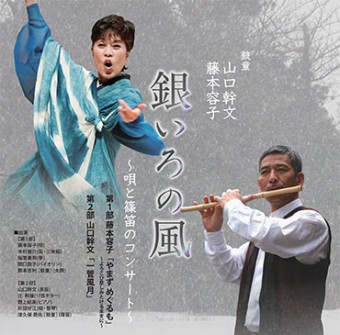
Here is a new piece by Motofumi Yamaguchi, which he will play during the second part of tomorrow’s Gin-iro no Kaze (Silver Wind) Song & Bamboo Flute Concert at Kunitachi Geijutsu Sho-Hall, Kunitachi, Tokyo. He will perform it with Kosuke Urushikubo.
Click below to listen to a sample of it:
And here is a sample of a beautiful piece from Yoko Fujimoto’s latest album “Yamazu Megurumo,” which will feature in the first part of the concert:
December is a busy month, but we hope you will take the time to relax with us to the sounds of soothing vocals and melodic bamboo flutes. We are all waiting for you tomorrow in Kunitachi!
Gin-iro no Kaze (Silver Wind) Song & Bamboo Flute Concert
Date: Dec. 18 (Thu), 2014
Venue: Kunitachi Geijutsu Sho-Hall, Kunitachi, Tokyo
Doors Open: 18:30 Start: 19:00
Advance: 3,800 yen
At-the-door: 4,300 yen
Seating Details: All seats reserved. Please refrain from bringing preschoolers (ages 5 & under).
Event URL: http://www.kuzaidan.com/hall/e?2533
Ticket Outlets: Kunitachi Geijutsu Sho-Hall, Hakujuji (Coffee & Cake) Kunitachi Stn. South Exit Store, Shimada Stationery Store, Marronnier Kunitachi Stn. North Exit Store.
Inquiries: Kunitachi Geijutsu Sho-Hall Tel. 042-574-1515
http://www.kodo.or.jp/news/20141218kodo3days_en.html
“Motofumi Yamaguchi ‘Ikkan Fugetsu'” by Narumi Matsuda
Motofumi Yamaguchi “Ikkan Fugetsu” in Sammu, Chiba
On May 16, Naruto Cultural Center Wild Chrysanthemum Plaza presented Motofumi Yamaguchi’s “Ikkan Fugetsu” concert. This hall is near the home of Ranjo-san, the craftsman who makes the shinobue (bamboo flutes) we play.
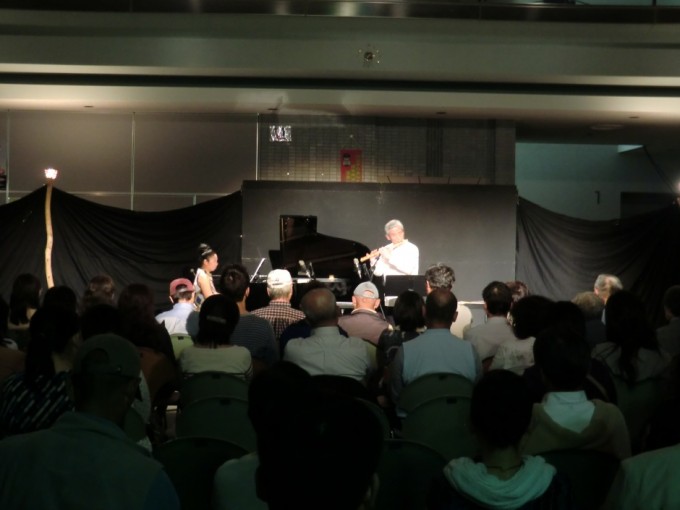
The venue erected a temporary stage in its entrance hall and sold beverages and snacks behind the audience seating. This setup made for a relaxed mood.
This was the 148th salon concert held by this hall. I saw some members in the audience who looked like they had come straight from working in their fields and they were relaxing as they listened to the concert. I could tell that these concerts are a firmly established event in this town.
Motofumi’s bamboo flute and talks to the audience created a great harmony with the piano and vocal performance by Yumi Nogami. After seeing this concert, I am already looking forward to their performances to come!
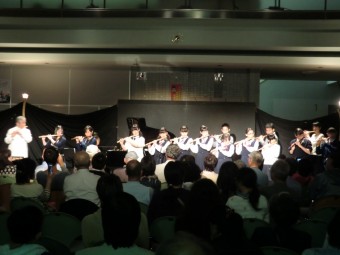
For the finale, Motofumi was joined by junior high school students to play “Hana wa Saku – Flowers Will Bloom, ” which is a song to support the regions affected by the Tohoku Pacific Earthquake. It was so moving.
Motofumi Yamaguchi Solo Album “Ikkan Fugetsu”
This is the debut solo album by Motofumi Yamaguchi, Kodo’s principal flautist. Recorded at Kodo Village using makobue flutes made from local Sado madake bamboo, this “home-grown” album has a deep, rich sound. This is a collection of original songs and beautiful arrangements of folk favorites from around the world.
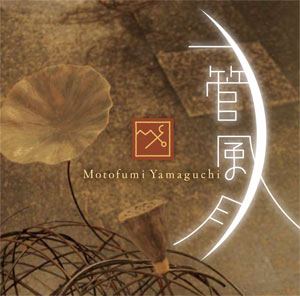
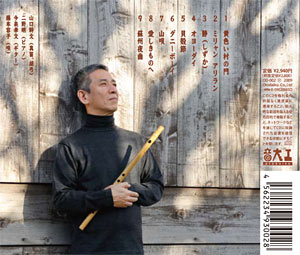
You can listen to album tracks “Gaftai Baile Bui(Irish Folk Song)” and “Yamauta” on YouTube.
http://www.youtube.com/playlist?list=PL71EF72F1AF905372
For orders, please visit the Kodo Online Store:
http://kodo.shop.multilingualcart.com/goods_en_jpy_10.html
This album is also available on iTunes.
https://itunes.apple.com/album/id370207572




